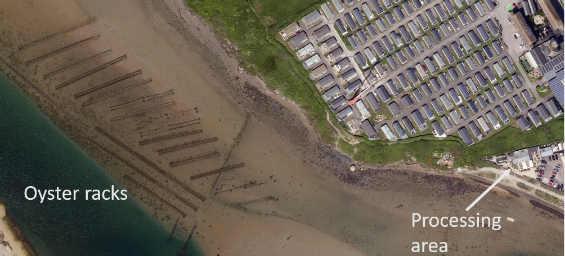Chesil Beach and the Fleet Lagoon
18 miles and 180 billion pebbles
Ferrybridge - Oyster farming

The Fleet at Ferrybridge provides an excellent environment for the farming of oysters. The native European oyster (Ostrea edulis) was found in the Fleet and harvested from Roman times. Later, Orc was granted ownership of the Fleet fishing rights along with areas of land and a number of villages in the Fleet hinterland. Orc wrote that “the Fleet has little fish except eels, flounders and grey mullet, but is noted for its oyster beds”.
The fishing rights passed to the Abbot at Abbotsbury until the dissolution of the monasteries in 1543. They then passed to Sir Giles Strangways whose descendants still own the Fleet and the fishing rights.
In 1743 a Captain Lysle purchased seed oysters from France and placed them in the Fleet adjacent to Wyke Regis.
This seems to have been successful as it appears to have still been running when J. Meade Faulkner wrote the book Moonfleet in 1898 as the opening paragraph includes “…is good for nothing except sea-fowl, herons, and oysters..”
However, it was not to last. A port isolation hospital for fever sufferers was built in southern Wyke above the shore of the Fleet and this seems to have impacted the oysters from the Fleet. A few native oysters continued to colonise the Fleet into the twentieth century.
In the early 1970’s MAFF conducted limited trials of growing the Pacific oyster (Crassostrea gigas) which were successful, but permission to establish a farm was refused by the owners.
In 1990 a new venture was given permission to start a farm. Abbotsbury Oysters started growing Pacific oysters using a bag and rack technique on the sand flats below the caravan camp.
The farm changed hands in 2004 and the trestles were completely replaced using an Australian post and rail system.
Once the oysters are mature they are taken to purification tanks in a processing plant located below the caravan camp near to where the Tod boatyard was located.
Information presented here partly extracted from ‘All about Ferrybridge’ by Doug Hollings.


These links can provide more information:
For the oyster farm click here.
For oyster farming click here.
For the pacific oyster click here.
For the native oyster click here.
Early oyster farms grew the native flat oyster Ostrea edulis, but this species is very prone to a number of diseases, particularly bonamia, A parasitic rhizarian, which can cause increased mortality. Oyster farms now grow the Pacific oyster, Crassostrea gigas, which is immune to bonamia and has the added advantage of reaching maturity in half the time of the native oyster.
When introduced it was believed that the Pacific Oyster could not survive in the wild in UK waters as the mean water temperature was too low for the spat to survive. The Fleet farm imports juvenile oysters from warmer waters and then grows them to maturity.
However, possibly due to higher water temperatures, Pacific oysters are now regularly found around the Lower Fleet well away from the oyster farm.


